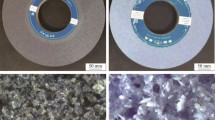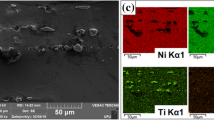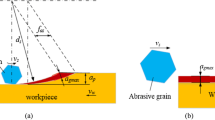Abstract
The grindability and sensibility analysis of surface roughness of powder metallurgy nickel-base superalloy FGH96 were studied in comparison to the wrought nickel-base superalloy GH4169. The effects of grinding parameters (such as workpiece infeed speed, depth of cut, and abrasive wheel speed) on grinding force, grinding temperature, specific grinding energy, abrasive wheel wear, and surface roughness were analyzed. The results show that the grinding force, grinding temperature, and specific grinding energy of GH4169 are usually higher than those of FGH96 under the given experimental conditions. However, the wear behavior of the brown corundum abrasive wheels when grinding these two kinds of nickel-base superalloy material is generally identical. The sensitivity of GH4169 workpiece surface roughness to depth of cut and workpiece infeed speed is higher than that of FGH96, but the sensitivity of GH4169 to abrasive wheel speed is less than that of FGH96. Finally, it is inferred that the grinding performance of FGH96 is slightly better than that of GH4169.
Similar content being viewed by others
References
Ding WF, Xu JH, Cheng ZZ, Fu YC (2010) Grindability and surface integrity of cast nickel-base superalloy in creep feed grinding with brazed CBN abrasive wheels. Chin J Aeronaut 23:501–510
Devillez A, Coz GL, Dominiak S, Dudzinski D (2011) Dry machining of Inconel 718 workpiece surface integrity. J Mater Process Technol 211:1590–1598
Pusavec F, Deshpande A, Yang S, M'Saoubi R, Kopac J, Dillon OW Jr, Jawahir IS (2014) Sustainable machining of high temperature nickel alloy - Inconel 718: part 1 - predictive performance models. J Clean Prod 81:255–269
Wang YG, Li CH, Zhang YB, Yang M, Zhang XP, Zhang NQ, Dai JJ (2017) Experimental evaluation on tribological performance of the wheel/workpiece interface in minimum quantity lubrication grinding with different concentrations of Al2O3 nanofluids. J Clean Prod 142:3571–3583
Dai CW, Ding WF, Zhu YJ, Xu JH, Yu HW (2018) Grinding temperature and power consumption in high speed grinding of Inconel 718 nickel-base superalloy with a vitrified CBN wheel. Precis Eng 52:192–200
Dudzinski D, Devillez A, Moufki A, Larrouquere D, Zerrouki V, Vigneau J (2004) A review of developments towards dry and high speed machining of Inconel 718 alloy. Int J Mach Tools Manuf 44:439–456
Bhatt A, Attia H, Vargas R, Thomson V (2010) Wear mechanisms of WC coated and uncoated tools in finish turning of Inconel 718. Tribol Int 43:1113–1121
Sugihara T, Takemura S, Enomoto T (2016) Study on high-speed machining of Inconel 718 focusing on tool surface topography of CBN cutting tool. Int J Adv Manuf Technol 87:9–17
Du J, Liu ZQ (2013) Damage of the machined surface and subsurface in orthogonal milling of FGH95 superalloy. Int J Adv Manuf Technol 68:1573–1581
Du J, Liu ZQ, Yi W, Su G (2011) Influence of cutting speed on surface integrity for powder metallurgy nickel-base superalloy FGH95. Int J Adv Manuf Technol 56:553–559
Du J, Liu ZQ (2012) Effect of cutting speed on surface integrity and chip morphology in high-speed machining of PM nickel-base superalloy FGH95. Int J Adv Manuf Technol 60:893–899
Huddedar S, Chitalkar P, Chavan A, Pawade RS (2012) Effect of cooling environment on grinding performance of nickel based superalloy Inconel 718. J Appl Sci 12:947–954
Qian N, Ding W, Zhu Y (2018) Comparative investigation on grindability of K4125 and Inconel718 nickel-base superalloys. Int J Adv Manuf Technol 97:1649–1661
Xi XX, Ding WF, Fu YC, Xu JH (2018) Grindability evaluation and tool wear during grinding of Ti2AlNb intermetallics. Int J Adv Manuf Technol 94:1441–1450
Balan ASS, Vijayaraghavan L, Krishnamurthy R, Kuppan P, Oyyaravelu R (2016) An experimental assessment on the performance of different lubrication techniques in grinding of Inconel 751. J Adv Res 7:709–718
Jia DZ, Li CH, Zhang YB, Yang M, Wang YG, Guo SM, Cao HJ (2017) Specific energy and surface roughness of minimum quantity lubrication grinding Ni-based alloy with mixed vegetable oil-based nanofluids. Precis Eng 50:248–262
Guo SM, Li CH, Zhang YB, Wang YG, Li BK, Yang M, Zhang XP, Liu GT (2017) Experimental evaluation of the lubrication performance of mixtures of castor oil with other vegetable oils in MQL grinding of nickel-base alloy. J Clean Prod 140:1060–1076
Li S, Wu Y, Nomura M (2016) Effect of abrasive wheel ultrasonic vibration on chip formation in surface grinding of Inconel 718. Int J Adv Manuf Technol 86:1113–1125
Yao CF, Jin QC, Huang XC, Wu DX, Ren JX, Zhang DH (2013) Research on surface integrity of grinding Inconel718. Int J Adv Manuf Technol 65:1019–1030
Hecker RL, Liang SY (2003) Predictive modeling of surface roughness in grinding. Int J Mach Tools Manuf 43:755–761
Ding WF, Dai CW, Yu TY, Xu JH, Fu YC (2017) Grinding performance of textured monolayer CBN wheels: Undeformed chip thickness nonuniformity modeling and ground surface topography prediction. Int J Mach Tools Manuf 122:66–80
Zhang MJ, Li FG, Wang SY (2011) Effect of powder preparation technology on the hot deformation behavior of HIPed P/M nickel-base superalloy FGH96. Mater Sci Eng A 528:4030–4039
Peng Z, Tian GF, Jiang J, Li MZ, Chen Y, Zou JW, Dunne FP (2016) Mechanistic behaviour and modelling of creep in powder metallurgy FGH96 nickel superalloy. Mater Sci Eng A 676:441–449
Malkin S, Guo C (2008) Grinding technology: theory and applications of machining with abrasives, 2nd edn. Industrial Press, New York
Chen JY, Huang H, Xu XP (2010) Grinding characteristics in high speed grinding of engineering ceramics with brazed diamond wheels. J Mater Process Technol 210:899–906
Yang M, Li CH, Zhang YB, Jia DZ, Zhang XP, Hou YL, Li RZ, Wang J (2017) Maximum undeformed equivalent chip thickness for ductile-brittle transition of zirconia ceramics under different lubrication conditions. Int J Mach Tools Manuf 122:55–65
Tang J, Du J, Chen Y (2009) Modeling and experimental study of grinding forces in surface grinding. J Mater Process Technol 209:2847–2854
Heinzel C, Bleil N (2007) The use of the size effect in grinding for work-hardening. CIRP Ann Manuf Technol 56:327–330
Zhang JC, Li CH, Zhang YB, Yang M, Jia DZ, Hou YL, Li RZ (2018) Temperature field model and experimental verification on cryogenic air nanofluid minimum quantity lubrication grinding. Int J Adv Manuf Technol 96:1–20
Yin GX, Marinescu ID (2017) A heat transfer model of grinding process based on energy partition analysis and grinding fluid cooling application. J Manuf Sci Eng 139:121015
Qi H, Wen DH, Yuan QL, Zhang L, Chen ZZ (2017) Numerical investigation on particle impact erosion in ultrasonic-assisted abrasive slurry jet micro-machining of glasses. Powder Technol 314:627–634
Qi H, Wen DH, Lu CD, Li G (2016) Numerical and experimental study on ultrasonic vibration-assisted micro-channelling of glasses using an abrasive slurry jet. Int J Mech Sci 110:94–107
Yang M, Li CH, Zhang YB, Jia DZ, Zhang XP, Hou YL, Shen B, Li RZ (2018) Microscale bone grinding temperature by dynamic heat flux in nanoparticle jet mist cooling with different particle sizes. Mater Manuf Process 33:58–68
Mao C, Zou H, Huang Y, Li Y, Zhou ZX (2013) Analysis of heat transfer coefficient on workpiece surface during minimum quantity lubricant grinding. Int J Adv Manuf Technol 66:363–370
Mohanta L, Sohag FA, Cheung FB, Bajorek SM, Kelly JM, Tien K, Hoxie CL (2017) Heat transfer correlation for film boiling in vertical upward flow. Int J Heat Mass Transf 107:112–122
Yao CF, Tan L, Yang P, Zhang DH (2018) Effects of tool orientation and surface curvature on surface integrity in ball end milling of TC17. Int J Adv Manuf Technol 94:1699–1710
Ulutan D, Ozel T (2011) Machining induced surface integrity in titanium and nickel alloys: a review. Int J Mach Tools Manuf 51:250–280
Rabiei F, Rahimi AR, Hadad MJ, Ashrafijou M (2014) Performance improvement of minimum quantity lubrication (MQL) technique in surface grinding by modeling and optimization. J Clean Prod 86:447–460
Tian WJ, Li Y, Ren JX, Yao CF (2016) Sensitivity analysis of the influence of milling parameters on the surface residual stress of titanium alloy TC11. Procedia CIRP 56:149–154
Yao CF, Wu DX, Tan L, Ren JX, Shi KN, Yang ZC (2013) Effects of cutting parameters on surface residual stress and its mechanism in high-speed milling of TB6. Proceedings of the institution of mechanical engineers part B. J Eng Manuf 227:483–493
Funding
This work was financially supported by the National Natural Science Foundation of China (No. 51775275), the Fundamental Research Funds for the Central Universities (No. NE2014103).
Author information
Authors and Affiliations
Corresponding author
Rights and permissions
About this article
Cite this article
Li, B., Ding, W., Yang, C. et al. Grindability of powder metallurgy nickel-base superalloy FGH96 and sensibility analysis of machined surface roughness. Int J Adv Manuf Technol 101, 2259–2273 (2019). https://doi.org/10.1007/s00170-018-3117-0
Received:
Accepted:
Published:
Issue Date:
DOI: https://doi.org/10.1007/s00170-018-3117-0




